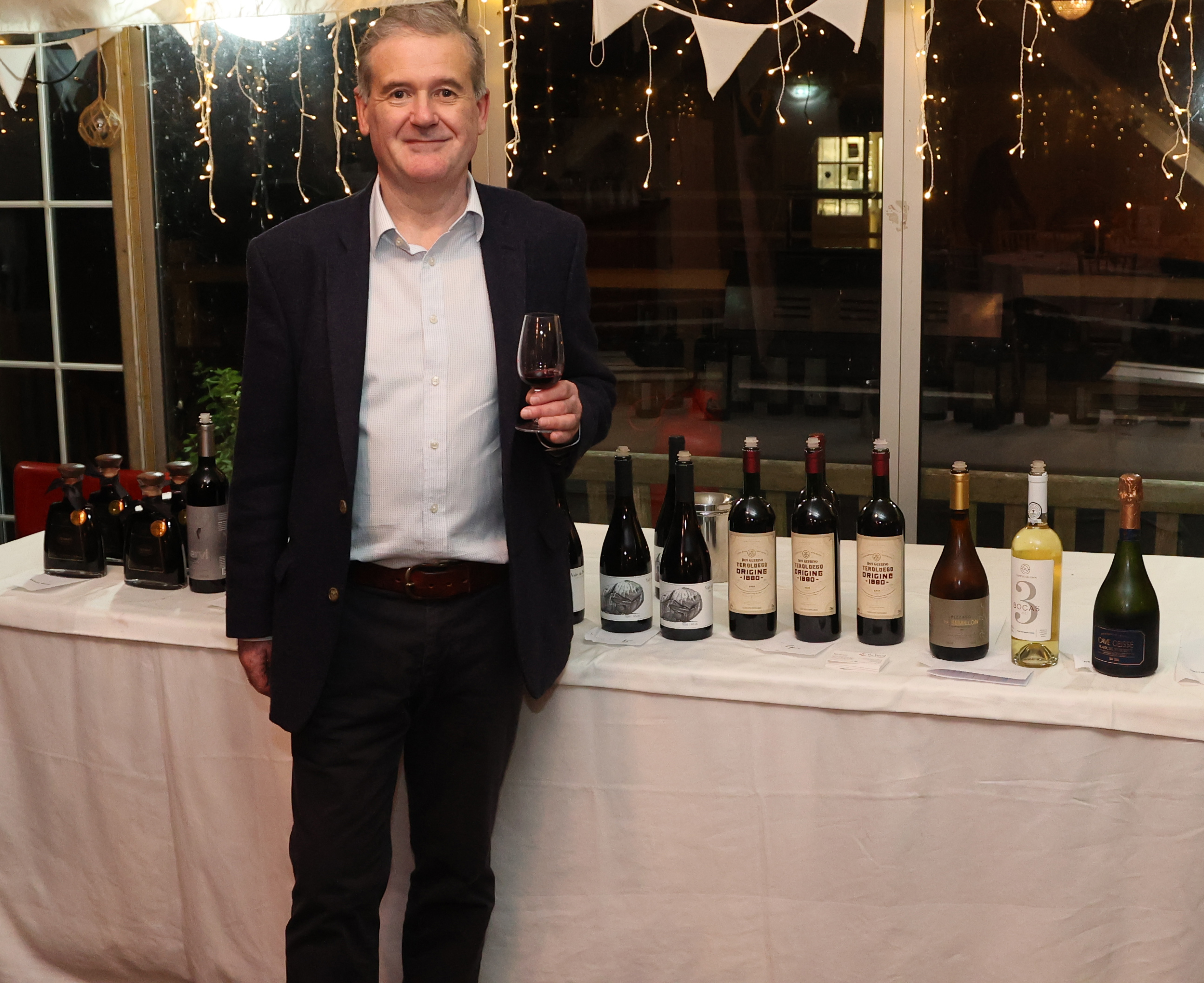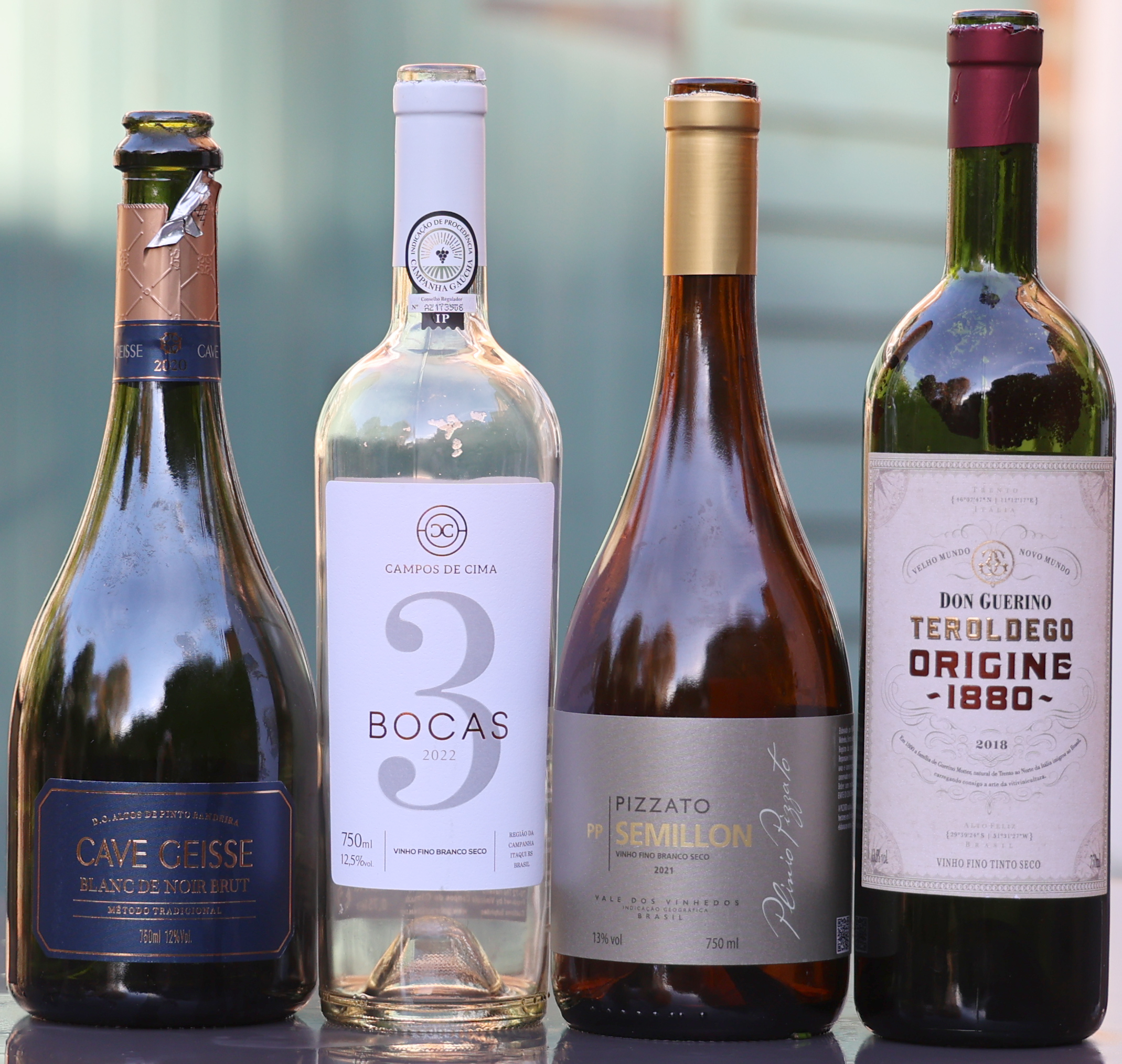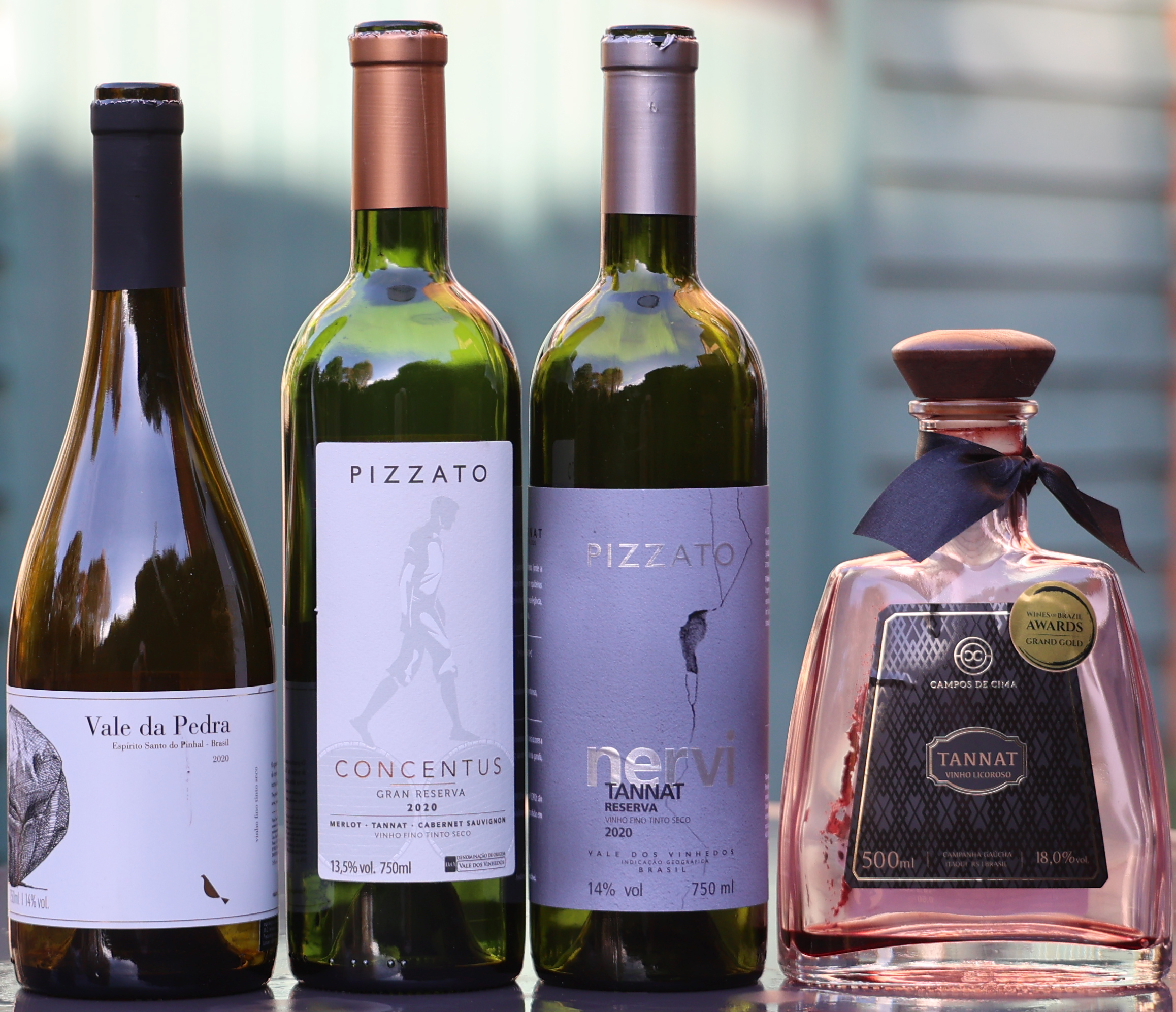 A little over 40 OWC members and guests attended a tasting of wines from Brazil, presented by Nicholas Corfe, Managing Director of Go Brazil Wine and Spirits. We tasted a range of eight quality wines from recent vintages ranging from a traditional method sparkling wine to a fortified late harvest Tannat. The vast majority of those present had never before tasted good quality Brazilian wines. Thus, the evening proved to be an eye-opening and informative moment for many. Before sampling the wines, Nic gave us a brief outline of the history and geography of winemaking in Brazil which I have attempted to summarise below.
A little over 40 OWC members and guests attended a tasting of wines from Brazil, presented by Nicholas Corfe, Managing Director of Go Brazil Wine and Spirits. We tasted a range of eight quality wines from recent vintages ranging from a traditional method sparkling wine to a fortified late harvest Tannat. The vast majority of those present had never before tasted good quality Brazilian wines. Thus, the evening proved to be an eye-opening and informative moment for many. Before sampling the wines, Nic gave us a brief outline of the history and geography of winemaking in Brazil which I have attempted to summarise below.
All of the wines provoked a good deal of comment and discussion from participants. The first wine in particular, a Blanc de Noirs, led to many positive observations and comparisons with other more well known traditional method sparkling wines including those from the UK and even Champagne. After such an auspicious start, we went on to enjoy two more white wines, four reds and finally a not overly sweet dessert wine.
By the end of the tasting the consensus amongst the attendees was that we had enjoyed some very impressive, though understandably not always inexpensive wines. With order forms supplied on our tables, a good number of us took the opportunity to buy some of the wines for more leisurely tasting and appreciation over the coming weeks. Some bottles may even also find their rightful place maturing in members cellars!
Thanks and appreciaition for his presentation were conveyed to Nic. With Brazilian winemakers continuing to make strides and simultaneously improve the quality and value of their wines, we can surely look forward to more pleasant surprises from Brazilan wines in the future.
Although it was the Portuguese who first introduced vines to Brazil in the 16th century, Brazil’s commercial wine-making heritage can be traced back nearly 150 years, to the last quarter of the 19th century, when the first of many Italian emigrants arrived in the south of the country and started putting their existing wine-making skills to good use.
The modern Brazilian wine industry still retains an Italian feel, not least because many of the descendants of those original settlers are involved in wine-making, and sometimes within wineries which still bear their family name. Since the turn of the 21st century, however, many new vineyards wineries have appeared, owned by wealthy entrepreneurs or families with very different backgrounds.
With roughly 83,000 hectares (205,000 acres) of vineyard, it ranks just behind its near-neighbors Argentina and Chile in terms of acreage under vine. Only a small proportion (about 10 percent) of these acres are planted with Vitis vinifera vines, however this large acreage does not translate into large volumes of quality wine. Although, over the last 10 years there has been a sustained improvement in quality.
Around 90% of Brazil’s vineyards are situated in the far south of the country. This is a vast region, bordering both Argentina and Uruguay, and comprising the states of Rio Grande do Sul and Santa Catarina. Although technically sub-tropical, it is relatively cool compared with the rest of the country, with fog, frosts and rain all commonplace. Altitude plays an important role too, varying from around 600m in the Serra Gaúcha hills down to 150m in the most southerly Campanha region. This contrasts markedly with the more northerly uplands of Santa Catarina, Brazil’s coldest state, where the highest peak reaches 1827m (>6000’) and snow is not unusual!
These temperate conditions favour the production of sparkling wine – for which Brazil now has an international reputation – but both red and white grapes intended for the production of still wines benefit from a long growing season and generally hot summers.
There are however a couple of exceptions to the above:
New wineries have started to emerge in the state of São Paulo, whose capital city (also São Paulo) lies on the Tropic of Capricorn at 23.4° latitude. This region it is too hot and too wet to harvest grapes during the normal January-March season experienced further south so, ingeniously, the harvest is delayed until the winter months of July-August, when the weather is much cooler and drier. A newly developed technique allows for an extra pruning of the vines, which delays the onset of the fruit. The São Paulo-based Guaspari winery, which first planted vines only 20 years ago, and is creating some much acclaimed wines using these methods.
Second, mention must be made of the vineyards of northeast Brazil, situated alongside the banks of the River São Francisco on the border of the states of Pernambuco and Bahia. Here, due to the region’s proximity to the Equator (at 8-9°), there are no seasons and thanks to constant irrigation the vines produce at least two harvests per year!
NB September 2023 issue of Decanter with article on wines from Brazil.
https://www.decanter.com/premium/discovering-brazils-flourishing-wine-scene-plus-10-wines-to-seek-out-510500/
The wines
- Familia Geisse Blanc de Noirs 2020 £24.99 12%
Cave Geisse, owned by Mario Geisse, a Chilean of German extraction, is located in a wonderfully scenic area known as Pinto Bandeira in the Vinhos de Montanha (‘Wine Mountains’), to the south of Bento Gonçalves. The site sits at an average 800m altitude, on well drained soil and enjoys plenty of sun, albeit with an average rainfall of 1,400mm – in other words, near perfect for small scale sparkling wine production. On 29 November 2022, the Altos de Pinto Bandeira became the first DO in South America exclusively for traditional-method sparkling wines. Yields are limited to 12 tonnes per hectare (as in Champagne).
the Vinhos de Montanha (‘Wine Mountains’), to the south of Bento Gonçalves. The site sits at an average 800m altitude, on well drained soil and enjoys plenty of sun, albeit with an average rainfall of 1,400mm – in other words, near perfect for small scale sparkling wine production. On 29 November 2022, the Altos de Pinto Bandeira became the first DO in South America exclusively for traditional-method sparkling wines. Yields are limited to 12 tonnes per hectare (as in Champagne).
Made entirely from Pinot Noir grapes, this brut Blanc de Noirs has been aged on the lees for a minimum 36 months. It has 12% abv. and 8.5gm/ltr. residual sugar; some 15000 bottles were produced. The 2019 vintage [there are no NV sparkling wines], scored a stunning 94 points in the September 2023 Decanter magazine!
A sophisticated wine with a generous mousse, a powerful nose exhibiting toasted, brioche aromas. Some spicy notes alongside dried fruits with a rich [touches of honey?] and creamy palate. Has a juicy and penetrating acidity. The bubbles, tend to be very soft, filling the entire palate. Recommended as a ‘food wine’, for example enjoyed with scallop ceviche.
Vineyard website: https://loja.familiageisse.com.br/cave-geisse/cave-geisse-blanc-de-noir-brut
- Campos de Cima Três Bocas Branco 2022 £14.99 12.5%
Located in the extreme Southwest of Brazil in the region of Campanha Oriental that can can only be accessed by a handful of roads. Campos de Cima is a boutique winery comprised of a 15 hectare vineyard on a gently sloping, north-facing hillside outside the town of Itaqui.
This dry wine is an intriguing blend of three white grapes, Alvarinho [45%], Assyrtiko [40%] (replacing the Viognier of earlier vintages) and Arinto [15%]. 2200 bottles were produced. Richly aromatic with roasted nut and citrus aromas, and lots of creamy nougat. In contrast, the palate is bone-dry with wonderful acidity. Bright and mineral-citrus in style with grapefruit and melon notes, a green leafiness and satisfying lemon finish. 91 points from Decanter. Partner with seafood, salads and fish dishes.
Vineyard website: https://en.camposdecima.com.br/enoturismo
- Pizzato PP Semillon 2021 £18.49 13%
The Pizzato vineyards, first established in 1879, are located in the Serra Gaúcha wine region region in the southern state of Rio Grande do Sul, where Brazil meets Uruguay. The landscape here is characterized by low mountain ranges (serras). The altitude and mountainous topography here are vital to the area's suitability for viticulture, providing cooling temperatures to create a longer growing season and higher acid retention.
This wine comes from the Vale dos Vinhedos, in Bento Gonçalves which in 2002 became Brazil’s first Geographical Indication (GI). The Serra Gaúcha region became a Denomination of Origin (DO) in 2012. The Pizzato family owned winery here has vineyards dating from 1968. The semillion vines for this wine were planted in 2012. The terroir is basaltic, clay based, scattered with small rocks. The vineyards are aligned north-south at 600m altitude. Climatic influences in the Vale dos Vinhedos range from subtropical to temperate.
Flavio Pizzato is the only winemaker producing Semillon in Brazil. Partial ageing in oak and acacia barrels for eight months adds complexity and texture to the beautifully balanced, harmonious palate. Deep straw yellow in colour, exhibiting aromas of ripe yellow fruits, wild flowers and sweet spices. There are layers of citrus and yellow fruit, nuttiness, delicate peach hints, herbaceous earthiness and a touch of savoury smokiness. All underpinned by focused excellent acidity. Only 5,550 bottles were produced. 92 points from Decanter. Possibly a difficult wine to match with food though Nic suggests white/ cured meats, fish and salads.
Vineyard website: https://www.pizzato.net
-
- Don Guerino 1880 Origine Teroldego 2018 £14.99 13.5%
The Don Guerino estate is located at Alto Feliz in Rio Grande do Sul, the southernmost state of Brazil. Their 60h of vineyards occupying a privileged microclimate within the Serra Gaúcha wine region, are situated at 450 m altitude on rich red clay slopes surrounded by sub-tropical forest.
Well adapted to the terroir of the Don Guerino vineyards, the Teroldego red grape variety originates in the northeastern region of Trentino-Alto Adige/Südtirol, Italy. 1880 is a reference to the year the vineyard’s founder emigrated from Trentino to Brazil. Hand harvested the juice is cold macerated for 3 days after which selected yeasts are added, fermentation then taking place at 25C. Malolactic fermentation is allowed to occur. Finally the wine is aged for 9 months in French and American oak barrels before bottling. It is of an exceptionally deep, inky-purple colour with aromas of dense dark brambly fruit, with hints of raspberry or redcurrant. On the palate, ripe black cherry, licorice, traces of vanilla and even a touch of smokiness are all apparent. It has an ageing potential of up to 8 years. It pairs well with traditional Italian dishes, is a perfect match for roast lamb, pork or beef, game and venison as well as strongly flavoured cheeses.
Vineyard website: https://www.donguerino.com.br/linha/conceito/teroldego-origine-1880
- Guaspari Vale da Pedra Tinto 2020 £25.49 14%
 The Guaspari winery, catering mainly to the elite of Sao Paulo, is located on the site of an old coffee plantation in the highlands of São Paulo state. The 700 hectare estate also grows and trades coffee.
The Guaspari winery, catering mainly to the elite of Sao Paulo, is located on the site of an old coffee plantation in the highlands of São Paulo state. The 700 hectare estate also grows and trades coffee.
Despite the vineyard’s high altitude (900-1200m), it is usually too hot and wet to harvest during February or March, as would typically occur in the more southerly wine regions. Guaspari have developed a technique to delay the budding and an additional second pruning of the vines takes place. The harvest is thus delayed until the cooler and drier winter months of July and August, and allows the grapes to ripen more slowly before reaching maturity.
This Tinto is made from 100% Syrah hand harvested from four different 1200m high vineyards planted on granitic-rich soils. Aged in used French oak barriques for 8-9 months, then rested in bottle for a minimum of 12 months prior to release. A deep ruby colour, on the nose it shows a spiciness typical of the varietal, together with a concentration of red fruits and a floral perfume of rosemary and dried herbs. Medium to full bodied, this is a powerful, well balanced and intense wine with a lovely lingering finish. Can be enjoyed with steaks, roast beef or lamb, venison and well seasoned/spiced dishes.pork as well as aged cheeses.
Vineyard website: https://www.vinicolaguaspari.com.br/home/
- Pizzato Gran Reserva Concentus 2020 £26.99 13.5%
This Reserva [the term has no legal definition in Brazil] is a serious, confident red blend – Merlot-dominant (65%) with Tannat (18%) and Cabernet Sauvignon (17%). Added complexity comes from barrel aging for 11 months in both French and American oak. Appealing aromas of ripe black and red fruit edged with florals and spice. Satisfying palate: velvety Merlot fruit is tempered with savoury spice and grip from the Cabernet and Tannat. Fine, well-integrated tannins and a long finish. 17100 bottles were produced. Well made and over-delivers! 93 points from Decanter. Ideally, it should be decanted. It can be enjoyed now but has cellaring potential for the next 10 years. Serve with roast beef or lamb and strong cheeses.
- Pizzato Reserva Nervi Tannat 2020 £18.49 13.5%
Made entirely from the historic Madiran (SW France) Tannat grape variety. Now also well established in Uruguay. This wine is made from from 25+ yr old vines and has been aged in new French oak barrels barrels for 11 months.
Nervi refers to the vivacious nature of the wine! Has a very deep purple-garnet appearance, and aromas with a huge concentration of dark berry fruit. some oakiness, traces of sweet spice – nutmeg and cinnamon, and even coconut. On the palate it demonstrates an elegant but ‘meaty’ palate of rich, ripe red and black fruit complemented by oak, vanilla and spicy notes. The wine is full bodied; tannins have started to soften, so wine is now approachable. To better appreciate ideally needs food such as roasted or grilled/BBQ red meats, game, venison, chilli con carne, spicy sausages or strongly flavoured cheeses. Ideally open well in advance and/or decant. An excellent aging potential.
- Campos de Cima Tannat ‘Licoroso’ NV £36.99 (500ml) 18%
A unique wine made entirely from late harvest Tannat grapes fortified with grape spirit. Separarated from the lees then barrel aged in French oak for 6 years. Only around 1000 bottles were produced. Dark, almost black in colour, the wine is rich, unctuous and heavily textured, and shows a nutty, dark chocolate and raisin character. Well balanced, it is neither dry nor particularly sweet. Pairs well with various desserts, cheeses or can simply be enjoyed on its own.
Go Brazil Wine and Spirits’ www.gobrazilwines.com
Prices given include 10% discount for orders made on the evening by OWC members.
Chris Blakey 25/10/23.